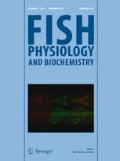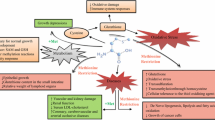Abstract
In this study, a selenoprotein W cDNA was cloned from topmouth culter (Erythroculter ilishaeformis), and it was designated as EISelW. The EISelW open reading frame was composed of 261 base pairs (bp), encoding 86-amino-acid protein. The 5′ untranslated region (UTR) consisted of 104 bp, and the 3′-UTR was composed of 365 bp. A selenocysteine insertion sequence (SECIS) element was found in the 3′-UTR of EISelW mRNA. The SECIS element was classified as form II because of a small additional apical loop presented in SECIS element of EISelW mRNA. Bioinformatic approaches showed that the secondary structure of EISelW was a β1-α1-β2-β3-β4-α2 pattern from amino-terminal to carboxy-terminal. Real-time PCR analysis of EISelW mRNAs expression in 17 tissues showed that the EISelW mRNA was predominantly expressed in liver, ovary, pituitary, various regions of the brain, spinal cord and head kidney. Study of intraperitoneal injection showed that the levels of EISelW mRNA in brain, liver, ovary and spleen were regulated by somatostatin 14 (SS14), 17β-estradiol (E2), cysteamine hydrochloride (CSH) and a binary mixture of E2 and CSH, dependent on the dosage. These results suggest that E2, SS14 and CSH status may affect tissues of selenium metabolism by regulating the expression of SelW mRNA, as SelW plays a central role in selenium metabolism.






Similar content being viewed by others
References
Aachmann FL, Fomenko DE, Soragni A, Gladyshev VN, Dikiy A (2007) Solution structure of selenoprotein W and NMR analysis of its interaction with 14-3-3 proteins. J Biol Chem 282:37036–37044
Allan CB, Lacourciere GM, Stadtman TC (1999) Responsiveness of selenoproteins to dietary selenium. Annu Rev Nutr 19:1–16
Atkins HL, Som P (1979) Growth-hormone and somatostatin effects on [75Se]selenomethionine uptake by the pancreas. J Nucl Med 20:543–546
Beilstein MA, Vendeland SC, Barofsky E, Jensen ON, Whanger PD (1996) Selenoprotein W of rat muscle binds glutathione and an unknown small molecular weight moiety. J Inorg Biochem 61:117–124
Bellingham MC, Berger AJ (1996) Presynaptic depression of excitatory synaptic inputs to rat hypoglossal motoneurons by muscarinic M2 receptors. J Neurophysiol 76:3758–3770
Burk RF, Hill KE (2015) Regulation of selenium metabolism and transport. Annu Rev Nutr 35:109–134
Canosa LF, Lin X, Peter RE (2002) Regulation of expression of somatostatin genes by sex steroid hormones in goldfish forebrain. Neuroendocrinology 76:8–17
Chambers I, Frampton J, Goldfarb P, Affara N, McBain W, Harrison PR (1986) The structure of the mouse glutathione peroxidase gene: the selenocysteine in the active site is encoded by the ‘termination’ codon, TGA. EMBO J 5:1221–1227
Chapple CE, Guigó R, Krol A (2009) SECISaln, a web-based tool for the creation of structure-based alignments of eukaryotic SECIS elements. Bioinformatics 25:674–675
Chen W, Zhang Z, Dong H, Jiang X (2015) Molecular cloning and sequence analysis of selenoprotein W gene and its mRNA expression patterns in response to metabolic status and cadmium exposure in goldfish, Carassius auratus. Comp Biochem Physiol B Biochem Mol Biol 184:1–9
Damdimopoulos AE, Miranda-Vizuete A, Treuter E, Gustafsson JA, Spyrou G (2004) An alternative splicing variant of the selenoprotein thioredoxin reductase is a modulator of estrogen signaling. J Biol Chem 279:38721–38729
Dikiy A, Novoselov SV, Fomenko DE, Sengupta A, Carlson BA, Cerny RL, Ginalski K, Grishin NV, Hatfield DL, Gladyshev VN (2007) SelT, SelW, SelH, and Rdx12: genomics and molecular insights into the functions of selenoproteins of a novel thioredoxin-like family. Biochemistry 46:6871–6882
Duntas LH, Benvenga S (2015) Selenium: an element for life. Endocrine 48:756–775
Finley JW, Kincaid RL (1991) Effect of sex and time of sampling on selenium and glutathione peroxidase activity in tissues of mature rats. Biol Trace Elem Res 29:181–191
Fletcher JE, Copeland PR, Driscoll DM, Krol A (2001) The selenocysteine incorporation machinery: interactions between the SECIS RNA and the SECIS-binding protein SBP2. RNA 7:1442–1453
Goody TA, Melcher SE, Norman DG, Lilley DM (2004) The kink-turn motif in RNA is dimorphic, and metal ion-dependent. RNA 10:254–264
Gu QP, Beilstein MA, Barofsky E, Ream W, Whanger PD (1999) Purification, characterization, and glutathione binding to selenoprotein W from monkey muscle. Arch Biochem Biophys 361:25–33
Gu QP, Sun Y, Ream LW, Whanger PD (2000) Selenoprotein W accumulates primarily in primate skeletal muscle, heart, brain, and tongue. Mol Cell Biochem 204:49–56
Guemouri L, Artur Y, Herbeth B, Jeandel C, Cuny G, Siest G (1991) Biological variability of superoxide dismutase, glutathione peroxidase, and catalase in blood. Clin Chem 37:1932–1937
Hall TR, Harvey S, Scanes CG (1986) Control of growth hormone secretion in the vertebrates: a comparative survey. Comp Biochem Physiol 84A:231–253
Hu BQ, Liu Y, Wen CG, Li AH, Hu XP, Wu D, Hu XJ, Tao ZY (2014) Cloning and expression of selenoprotein W from pearl mussels Cristaria plicata. Comp Biochem Physiol B Biochem Mol Biol 167:8–15
Hubert N, Walczak R, Carbon P, Krol A (1996) A protein binds the selenocysteine insertion element in the 3′-UTR of mammalian selenoprotein mRNAs. Nucleic Acids Res 24:464–469
Khanam A, Platel K (2016) Bioaccessibility of selenium, selenomethionine and selenocysteine from foods and influence of heat processing on the same. Food Chem 194:1293–1299
Krantic S (2000) Peptides as regulators of the immune system: emphasis on somatostatin. Peptides 21:1941–1964
Kryukov GV, Gladyshev VN (2000) Selenium metabolism in zebrafish: multiplicity of selenoprotein genes and expression of a protein containing 17 selenocysteine residues. Genes Cells 5:1049–1060
Labunskyy VM, Hatfield DL, Gladyshev VN (2014) Selenoproteins: molecular pathways and physiological roles. Physiol Rev 94:739–777
Li JL, Ruan HF, Li HX, Li S, Xu SW, Tang ZX (2011) Molecular cloning, characterization and mRNA expression analysis of a novel selenoprotein: avian selenoprotein W from chicken. Mol Biol Rep 38:4015–4022
Li Y, Gao S, Liu S, Liu B, Zhang X, Gao M, Cheng L, Hu B (2015) Excretion of manure-borne estrogens and androgens and their potential risk estimation in the Yangtze River Basin. J Environ Sci (China) 37:110–117
Lin SL, Wang CW, Tan SR, Liang Y, Yao HD, Zhang ZW, Xu SW (2014) Selenium deficiency inhibits the conversion of thyroidal thyroxine (T4) to triiodothyronine (T3) in chicken thyroids. Biol Trace Elem Res 161:263–271
Liu JL (1990) Effect of cysteamine on the exhaustion of somatotropin release inhibiting hormone and its mechanism. Sheng Li Ke Xue Jin Zhan 21:271–274
Livak KJ, Schmittgen TD (2001) Analysis of relative gene expression data using real-time quantitative PCR and the 2(−Delta Delta C(T)) method. Methods 25:402–408
Lopes PA, Santos MC, Vicente L, Rodrigues MO, Pavão ML, Nève J, Viegas-Crespo AM (2004) Trace element status (Se, Cu, Zn) in healthy Portuguese subjects of Lisbon population: a reference study. Biol Trace Elem Res 101:1–17
Low SC, Berry MJ (1996) Knowing when not to stop: selenocysteine incorporation in eukaryotes. Trends Biochem Sci 21:203–208
Martin GW 3rd, Harney JW, Berry MJ (1998) Functionality of mutations at conserved nucleotides in eukaryotic SECIS elements is determined by the identity of a single nonconserved nucleotide. RNA 4:65–73
Matsumura S, Ikawa Y, Inoue T (2003) Biochemical characterization of the kink-turn RNA motif. Nucleic Acids Res 31:5544–5551
Mistry HD, Wilson V, Ramsay MM, Symonds ME, Broughton Pipkin F (2008) Reduced selenium concentrations and glutathione peroxidase activity in preeclamptic pregnancies. Hypertension 52:881–888
Nelson LE, Sheridan MA (2005) Regulation of somatostatins and their receptors in fish. Gen Comp Endocrinol 142:117–133
Ou BR, Jiang MJ, Lin CH, Liang YC, Lee KJ, Yeh JY (2011) Characterization and expression of chicken selenoprotein W. Biometals 24:323–333
Pagmantidis V, Bermano G, Villette S, Broom I, Arthur J, Hesketh J (2005) Effects of Se-depletion on glutathione peroxidase and selenoprotein W gene expression in the colon. FEBS Lett 579:792–796
Patel YC (1999) Somatostatin and its receptor family. Front Neuroendocrinol 20:157–198
Pillon D, Caraty A, Fabre-Nys C, Lomet D, Cateau M, Bruneau G (2004) Regulation by estradiol of hypothalamic somatostatin gene expression: possible involvement of somatostatin in the control of luteinizing hormone secretion in the ewe. Biol Reprod 71:38–44
Pinto A, Speckmann B, Heisler M, Sies H, Steinbrenner H (2011) Delaying of insulin signal transduction in skeletal muscle cells by selenium compounds. J Inorg Biochem 105:812–820
Prohaska JR, Sunde RA (1993) Comparison of liver glutathione peroxidase activity and mRNA in female and male mice and rats. Comp Biochem Physiol B 105:111–116
Qi Y, Grishin NV (2005) Structural classification of thioredoxin-like fold proteins. Proteins 58:376–388
Rayman MP (2000) The importance of selenium to human health. Lancet 356:233–241
Sheridan MA, Hagemeister AL (2010) Somatostatin and somatostatin receptors in fish growth. Gen Comp Endocrinol 167:360–365
Siler TM, VandenBerg G, Yen SS, Brazeau P, Vale W, Guillemin R (1973) Inhibition of growth hormone release in humans by somatostatin. J Clin Endocrinol Metab 37:632–634
Sobocanec S, Balog T, Sverko V, Marotti T (2003) Sex-dependent antioxidant enzyme activities and lipid peroxidation in ageing mouse brain. Free Radic Res 37:743–748
Suryo Rahmanto A, Davies MJ (2011) Catalytic activity of selenomethionine in removing amino acid, peptide, and protein hydroperoxides. Free Radic Biol Med 51(12):2288–2299
Vendeland SC, Beilstein MA, Yeh JY, Ream W, Whanger PD (1995) Rat skeletal muscle selenoprotein W: cDNA clone and mRNA modulation by dietary selenium. Proc Natl Acad Sci USA 92:8749–8753
Walczak R, Carbon P, Krol A (1998) An essential non-Watson–Crick base pair motif in 3′UTR to mediate selenoprotein translation. RNA 4:74–84
Werner H, Koch Y, Baldino F Jr, Gozes I (1988) Steroid regulation of somatostatin mRNA in the rat hypothalamus. J Biol Chem 263:7666–7671
Whanger PD (2009) Selenoprotein expression and function—selenoprotein W. Biochim Biophys Acta 1790:1448–1452
Wilmer MJ, Kluijtmans LA, van den Heuvel LP, Levtchenko EN (2011) Cysteamine restores glutathione redox status in cultured cystinotic proximal tubular epithelial cells. Biochem Biophys Acta 1812:643–651
Xiao D, Lin HR (2003) Effects of cysteamine—a somatostatin-inhibiting agent–on serum growth hormone levels and growth in juvenile grass carp (Ctenopharyngodon idellus). Comp Biochem Physiol A Mol Integr Physiol 134:93–99
Xiao J, Kang X, Xie L, Qin Q, He Z, Hu F, Zhang C, Zhao R, Wang J, Luo K, Liu Y, Liu S (2014) The fertility of the hybrid lineage derived from female Megalobrama amblycephala × male Culter alburnus. Anim Reprod Sci 151(1–2):61–70
Yamamoto T, Ohkuwa T, Itoh H, Sato Y, Naoi M (2002) Effect of gender differences and voluntary exercise on antioxidant capacity in rats. Comp Biochem Physiol C Toxicol Pharmacol 132:437–444
Yeh JY, Beilstein MA, Andrews JS, Whanger PD (1995) Tissue distribution and influence of selenium status on levels of selenoprotein W. FASEB J 9:392–396
Yeh JY, Ou BR, Gu QP, Whanger PD (1998) Influence of gender on selenoprotein W, glutathione peroxidase and selenium in tissues of rats. Comp Biochem Physiol B Biochem Mol Biol 119:151–155
Zhang Y, Fomenko DE, Gladyshev VN (2005) The microbial selenoproteome of the Sargasso Sea. Genome Biol 6:R37
Zhang L, Li WS, Hong X, Lin HR (2009) Regulation of preprosomatostatin I (PSSI) gene expression by 17β-estradiol and identification of the PSSI promoter region in orange-spotted grouper (Epinephelus coioides). Mol Cell Endocrinol 311:87–93
Zhou X, Smith AM, Failla ML, Hill KE, Yu Z (2012) Estrogen status alters tissue distribution and metabolism of selenium in female rats. J Nutr Biochem 23:532–538
Zhou P, Zhang L, Li J, Luo Y, Zhang B, Xing S, Zhu Y, Sun H, Gao F, Zhou G (2015) Effects of dietary crude protein levels and cysteamine supplementation on protein synthetic and degradative signaling in skeletal muscle of finishing pigs. PLoS One 10:e0139393. doi:10.1371/journal.pone.0139393
Zorrilla R, Simard J, Rhéaume E, Labrie F, Pelletier G (1990) Multihormonal control of pre-pro-somatostatin mRNA levels in the periventricular nucleus of the male and female rat hypothalamus. Neuroendocrinology 52:527–536
Acknowledgments
This work was supported by the National Natural Science Foundation of China (No. 31402277), the Opening Foundation of Zhejiang Provincial Key Laboratory of Aquatic Resources Conservation and Development (No. SS201404) to Dr. Haiyan Dong.
Author information
Authors and Affiliations
Corresponding authors
Electronic supplementary material
Below is the link to the electronic supplementary material.
Rights and permissions
About this article
Cite this article
Dong, H., Chen, W., Sun, C. et al. Identification, characterization of selenoprotein W and its mRNA expression patterns in response to somatostatin 14, cysteamine hydrochloride, 17β-estradiol and a binary mixture of 17β-estradiol and cysteamine hydrochloride in topmouth culter (Erythroculter ilishaeformis). Fish Physiol Biochem 43, 115–126 (2017). https://doi.org/10.1007/s10695-016-0272-9
Received:
Accepted:
Published:
Issue Date:
DOI: https://doi.org/10.1007/s10695-016-0272-9




